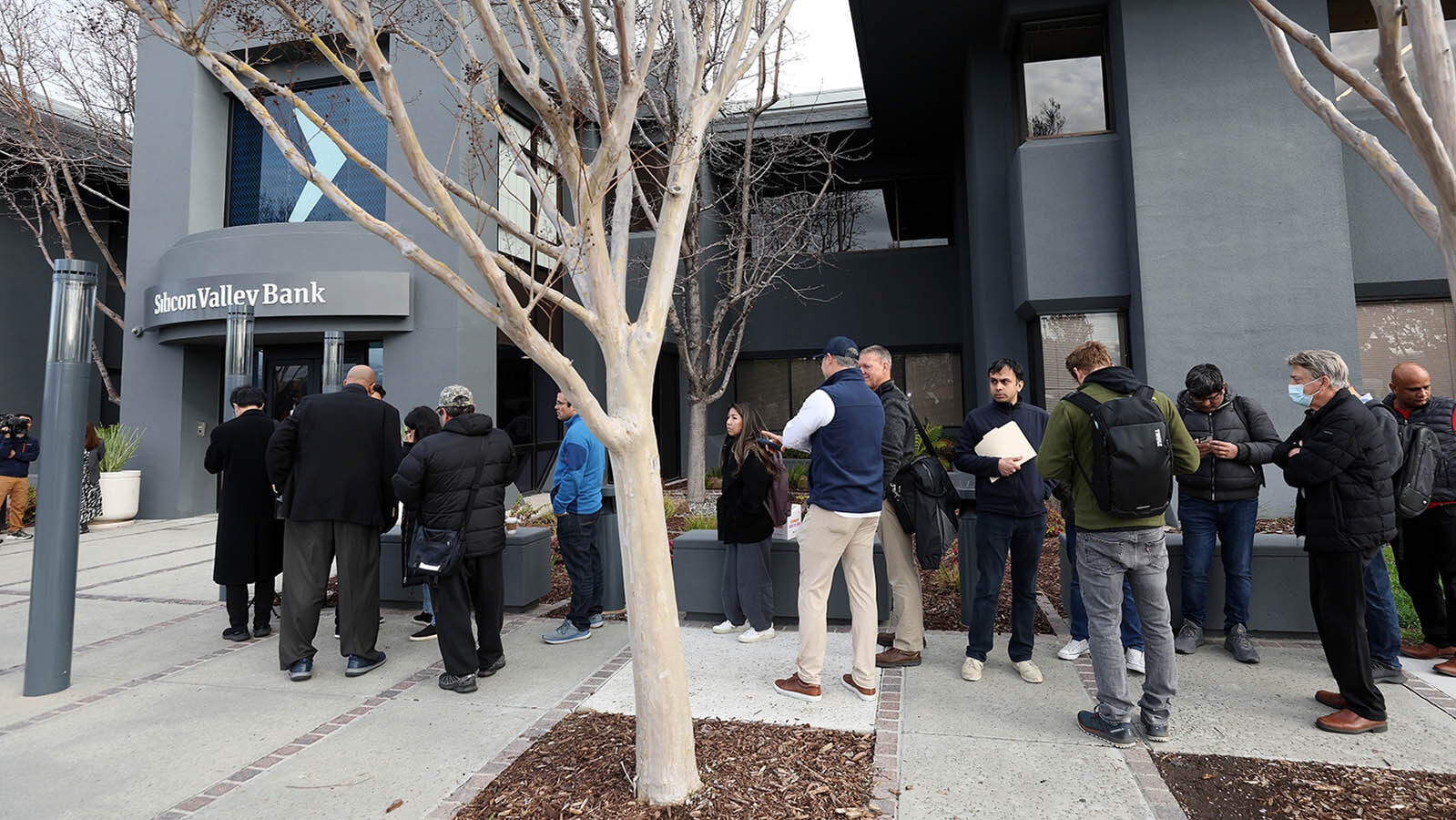With headlines about three bank closures marching across the news cycle all weekend, many Wyomingites are wondering whether their community bank is immune to the failure that hit the Silicon Valley, Signature and Silvergate banks.
It’s a fair question, particularly given that the regional bank index, which covers some of the largest regional banks in the nation, is down 10% Monday.
“Zions Bank (located in Utah) is down 40% today,” Wall Street veteran and digital assets expert Caitlin Long told Cowboy State Daily. “The moves in some of these stocks are just staggering. It’s incredible.”
But despite a poor showing on the stock market, Wyoming Bankers Association President/CEO Scott Meier believes that won’t happen to Wyoming banks.
“(Those) were incredibly unique situations,” he said. “Silicon Valley Bank is a much different bank than what we have here in Wyoming.”
Wyoming banks in particular don’t have the same concentrated exposure to the technology sector that Silicon Valley Bank and, to some extent, the Signature and Silvergate banks, had, Meier said.
The FDIC also estimates that a large majority of deposits at Wyoming banks are insured, which was not the case at the three banks that closed in as many days over the weekend.
Wyoming’s digital banks, or Special Purpose Depository Institutions, meanwhile are required to hold the value of any digital assets 100% on reserve, former state legislator Tyler Lindholm told Cowboy State Daily.
“Wyoming saw this coming,” Lindholm said. “We did. This is exactly what special purpose depositories were meant for. If you make a bank run on a special purpose depository, you don’t have a problem, because all of your money’s there.”
A Darling Of Silicon Valley
Exposure to cryptocurrencies was not what did Silicon Valley Bank in, despite the talking points coming out of President Joe Biden’s administration, Long said.
What caused its meltdown is a complex cascade of events that start with the nature of Silicon Valley Bank itself.
The bank billed itself as an innovation engine for startups. It supplied capital overwhelmingly to a large number of tech-oriented companies. This focus left it far less diversified than Wyoming banks, with much more broad exposure to the technology sector.
The tech sector is in a downturn, laying people off left and right, because many of the businesses overestimated — by a long shot — just how persistent their instant, COVID-19 inspired popularity would be.
An Atypical Model
That has these cash-strapped companies suddenly needing the money they stashed at Silicon Valley Bank — in amounts that were, in many cases, well above the $250,000 that FDIC will insure.
Banks, in general, have a time-tested strategy for covering depositors, so this ordinarily wouldn’t be the problem that it was for Silicon Valley Bank.
Banks generally invest heavily in highly secure, highly liquid assets like U.S. treasuries and low-risk mortgages that, under typical circumstances, can be quickly sold for the value that was put into them.
But the economy is not in typical straits.
The Federal Reserve’s recent jumbo-sized interest rate hikes make the treasuries and mortgages bought during the pandemic much less attractive than today. That means banks trying to cash in those otherwise secure assets to meet sudden withdrawals must do so at a significant loss.
It was the sell-off, at a loss, of devalued U.S. treasuries that ultimately spooked depositors at Silicon Valley Bank — particularly those whose deposits exceeded the FDIC-insured limit of $250,000 — sparking a good old-fashioned bank run at the modern-day speed of Twitter.
Signature Bank Was Different – Here’s Why
Fear is the virus that quickly spreads from one bank to another, causing a wipeout that can affect the sector at large.
Signature Bank, which also had a large number of venture capitalists and depositors exceeding the FDIC-insured limit of $250,000, was next in the daisy chain.
Bank officials reported a meteoric rise in withdrawals from Signature on Friday, with $10 billion flying out of the bank register that day.
But Signature Bank officials, which include Former U.S. Rep. Barney Frank, a co-author of the Dodd-Frank legislation that beefed up banking regulations, believed they had stabilized Signature bank by Sunday and said that it was solvent. It should have been able to ride out the situation Monday.
Frank has been widely quoted saying that federal regulators jumped the gun by forcing Signature Bank into receivership, and further suggested that the federal agencies involved just saw an opportunity to strong-arm cryptocurrency out of the U.S. banking sector altogether.
Signature was one of the last banks accepting cryptocurrency deposits in the United States.
Crypto Connection?
Long agreed with Frank that Signature’s takeover was likely motivated by federal regulators’ desire to shut digital assets out of the banking industry altogether.
“Silicon Valley is not a crypto-serving bank,” she said. “Silvergate was, but (their) bank run took longer than Silicon Valley. So, you know, I know the White House talking point today is to try to pin this on crypto, because, of course, they need a scapegoat. Because they screwed up.”
Long said the bank-run situation that has been caused by the Fed’s interest rate hikes raises an interesting point.
“A lot of people have come forward the last couple of days and said if the Fed is telling banks they need to be mindful of liquidity risk, why did they reject Custodia’s application?” Long said. “It doesn’t add up.”
As a Wyoming SPDI, Custodia Bank is required keep on reserve 100% of the value of any digital assets it holds. It has 100% liquidity.
Wyoming put that into its SPDI regulations for just that reason, Lindholm added.
“If you make a bank run on a special purpose depository, you don’t have a problem,” he said. “Because your money’s there. It’s a non-lending institution. It can’t leverage its customers funds.”
Will The Bank Run Contagion Spread?
Meier told Cowboy State Daily he doesn’t expect the contagion from Silvergate, Signature and Silicon Valley banks will spread to Wyoming.
“I can’t say it would never happen here, but I don’t think it’s very likely because our banks are well-diversified by statute and by rules from the Division of Banking, and they’re all well-capitalized,” he said. “So, I don’t think you would see that kind of shift in there, and you would never see a bank in Wyoming grow by 200% over a couple of years. That’s just unheard of.”
In his conversations with Wyoming banks about the situation, Meier said he’s heard some concern, but no panic.
He believes that is because FDIC estimates show a majority of Wyoming bank deposits fall under the insurance limit of $250,000, and banks here are more well-diversified both in customer base and in their investment portfolios.
“So, you might see somebody that’s going to jump out and say, ‘I want to go bank with Chase or Wells Fargo,’” he said. “But there’s really no need to be concerned that they’re going to lose their deposits like this bank, because they’ve got plenty of capital to take care of them.”
Steps Taken To Stop The Spread
The Federal Reserve has taken additional steps to limit the risk to banks, which have large exposure to devalued U.S. treasuries thanks to Federal Reserve rate hikes. It’s implemented a loan program, allowing those banks to borrow money against those assets, rather than being forced to sell them on the open market at a significant loss.
That should help banks ride out the storm caused by higher interest rates, Meier suggested.
Long and Lindholm, however, were not so sure that there isn’t some risk of the contagion spreading to other banks, though both said Wyoming banks are probably in better shape than elsewhere.
“I mean, we’ve already seen lots of folks reporting about several of these outfits, including Credit Suisse being underwater,” Lindholm said. “So that’s definitely alluding toward a bloodbath, or at least it certainly seems like it.”
Long, meanwhile, pointed to what’s happening on the bond and stock markets.
“If that had solved the problem, bank stocks would not be down, and they’re down big,” she said. “And you also see in the fixed-income market, interest rates have plunged on the two-year treasury. Since Thursday, they’re down 1% from 5%.
“I mean that is an enormous drop. That’s way out of the norm statistically. That tells you the bond market is very worried about contagion.”





